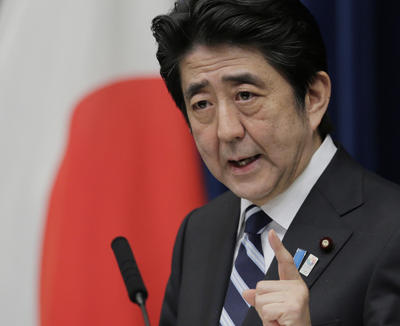And the electorate has rewarded Abe with exceptionally high ratings in the polls.
Overseas observers and the international markets have also been impressed with the decisiveness and direction of Japan’s new strategy. When you talk to top officials in Australia or in China, they are almost universally optimistic that Japan is at last getting its economic house in order. Escaping deflation is the first step. A modest boost to GDP growth is the second.
But will Japan’s growth flame sputter out and the Abe experiment end in tears?
In recent days, the old guard at the Bank of Japan has been publicly ringing alarm bells about ‘the dangers of a massive money-printing program, even while many economists say recent signs of slowdown call for a bigger dose of short-term stimulus’. The critics concede that the short term stimulus has been successful, but argue that Japan’s headed for big problems in the medium term. Either it will fail to end Japan’s long slump, or it will succeed to the point where the BOJ has to formulate an ‘exit policy’ from its current aggressive easing, along the lines of the US Federal Reserve’s current ‘tapering’. That’s when the dangerous day of reckoning could come, with transition to higher interest rates raising the cost of Japan’s huge government debt. So fiscal consolidation (raising taxes: the first tranche of which started on 1 April) is an important part of getting policy right and the timing of that is complicated, economically and politically. Too soon and it snuffs out the benefit of fiscal stimulus. Too late and it raises credit risk.
The allies of Bank of Japan Governor Haruhiko Kuroda and architects of Abenomics privately acknowledge the legitimacy of these concerns. But they respond that it’s way too soon to worry about the exit policy, with the economic recovery showing signs of fragility, and more forecasters betting that Mr Kuroda will fall well short of his 2 per cent-inflation-in-two-years target than overshoot it.
Almost everyone acknowledges that to work its magic in the longer term, the monetary and fiscal stimulus will have to be accompanied by a lift in growth and that, given Japan’s shrinking workforce, that’s not going to happen without a lift in productivity performance. So some of Abe’s closest advisors are worried that without grasping the structural reform nettle, the lift in productivity that is needed to succeed in re-booting the Japanese economy will not come any time soon.
Foreign economic policy reform, for example, is almost entirely focused on the Trans-Pacific Partnership negotiations, and has shied away from embracing the full monty — horse-trading at the edges of deregulation not embracing deep liberalisation. This is a limp (and traditionally conservative LDP) response to the need for agricultural and services sector reform, that can only really be delivered if there is preparedness for wholesale reconstruction of the regulatory framework that cossets these sectors behind protectionist walls, especially agriculture. Agriculture accounts for only around 1 per cent of GDP, but getting rid of the waste there is symbolically important to the credibility of the structural reform dimension of Abenomics.
As Aurelia George Mulgan demonstrates in her piece on where agricultural reform is at, there’s long way to go before the agricultural lobby will be cut loose. Abe’s third arrow (economic growth through structural reform) ‘is flying neither high nor fast in Japan’s agricultural sector’, she says, a warning of the likely limited outcomes from the Trans-Pacific Partnership and Australia-Japan FTA negotiations currently under way. As she explains, all the deregulation proposals for agricultural organisations are coming up against the ruling Liberal Democratic Party’s (LDP) own counterforce in the form of the ‘Project Team for Examining the Role of the JA in the New Agricultural Policy’. While Abe appears to enthuse about regulatory reforms, and his style of ‘advisory council politics’ (shingikai seiji) with high-profile business and academic members gives voice to reformers, this will not be enough if reform proposals end up substantially watered down by the LDP’s backbench or the bureaucracy. ‘On balance’, George Mulgan concludes, ‘none of the proposals … to date constitute serious structural reform’.
Is there better news on other fronts?
The announcement last month that Abe’s Special Economic Zones (SEZs or tokku) were going ahead offered some promise. In this week’s lead Naohiro Yashiro describes SEZs as the exception to the lack of inertia on structural reform. Yashiro explains that ‘this is a national project focusing on the economic development of Tokyo and other major metropolitan cities through regulatory reform and fiscal incentive measures … A major part of the reform includes raising the floor-area ratio so that it is possible to build higher apartment buildings in the limited land space in the city centre. The government will also waive a section of current regulations to allow private firms to run public schools and hospitals in the special zones, opening the sector up to foreign direct investment. This is just the first round of regulatory reform: the second and third round reforms are expected later this year’. There are also measures that aim at labour market deregulation in these zones.
Abe’s SEZs cover a good part of metropolitan Japan (over four-fifths of Japanese output according to one estimate) but the lingering question is why not the whole country? And are they really just a cover for another round of old-fashioned LDP-style industrial policy, with Kansai doing medical companies, for example, and Tokyo doing ‘global business’? It was not a good omen that the private members of Abe’s advisory group on tokku, Tatsuo Hatta and Heizo Takenaka (former prime minister Junichiro Koizumi’s reform lieutenant), pronounced the deregulatory measures that have been proposed for the Tokyo zone so far ‘wholly inadequate’.
There’s clearly a way to go before there can be confidence in delivery from Japanese stagnation.
Peter Drysdale is Editor of the East Asia Forum.

